Hiroshi Yoshida’s beloved Mount Hodaka
As the morning sun warms the chilly air, the lingering mist over the deep valley of Kamikochi gradually lifts, revealing the pale and silent peaks of Mt.Hodaka. The light cascading down from the crisp autumn sky causes the rough, rocky surface in the haze far above to glow white. Above, the scaly clouds slowly drift by.
Some of the finest glacial terrain in Japan, vertiginous rock ridges, and towering rock walls like folding screens. The Hodaka range boasts some of the most severe, rugged, and majestic alpine scenery in the Northern Alps. The scenery has never changed and continues to attract climbers in their droves.
Hodaka was the peak that Hiroshi Yoshida loved most of all. While he also liked Mt.Tsurugi and Mt.Yari, it is Hodaka that features so prominently in his body of works. In the three years from 1915, he produced a series of four oil paintings of it, and in 1921, produced his first woodblock engraving of a mountain landscape, depicting Hodaka. This was the period when Hiroshi was most energetic in visiting the Northern Alps, and it could be said that Hodaka was one of his motifs. Several of his works depict Kamikochi, also featuring Hodaka. The large woodblock print “Mt. Hodaka after the Rain” (1927), is the culmination of his work, a breathtakingly detailed and lucid depiction of the mist rising from the valley after the rain, and of Mt.Hodaka suspended in the moist air. Hiroshi wrote of this work, “The view from the bank of the Azusa River in the Kamikochi region is mesmerizing.”
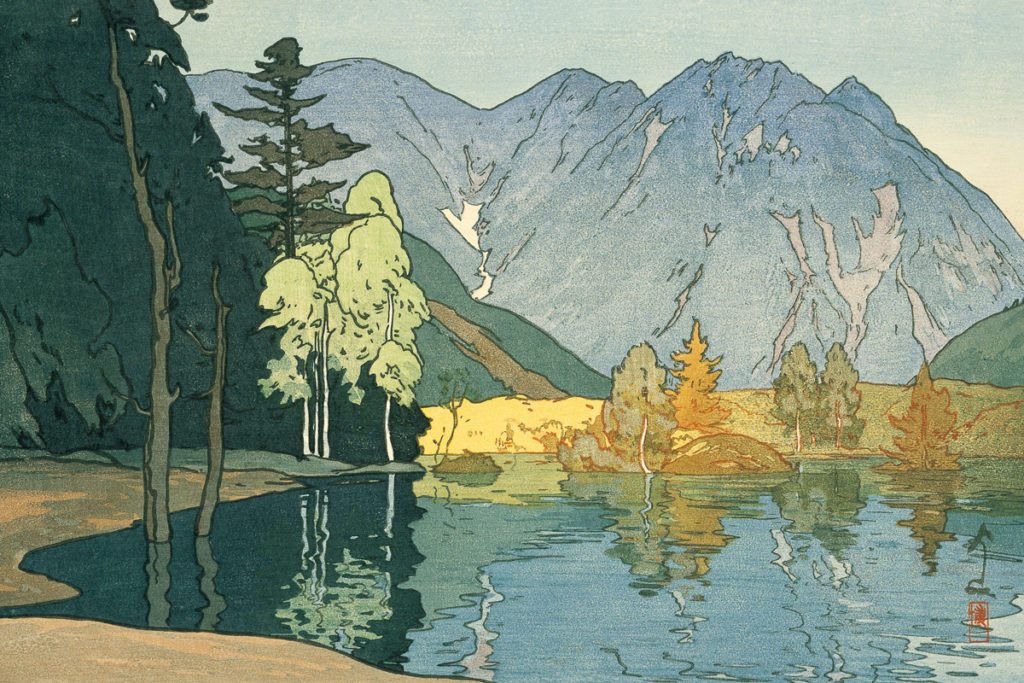
The deep green of coniferous trees is interspersed with bright green just beginning to change color, as well as ochre, yellow, and vermilion. The mountain path leads deeper into the Yokoo Valley, filled with soft colors that seem dry and faded. The small yellow leaves of the Erman’s birch trees glisten like ripples in the wind, before falling as if dancing. Before long, clouds began to spread across the sky and the pitter patter of rain makes itself known. The soft drizzle that falls slowly becomes a curtain of drops, which turn into particles of light as they catch the slanting sunlight that penetrates the clouds. Casting my gaze upward, I see a dim, snow-covered valley beneath the gray mist that hugs the ridge line. This mist, blotting out the faint color of the setting sun, tints the valley purple. The rain turns to sleet, which in turn becomes snow. By the time I reachedKarasawa, the snow had intensified, and that night, large snowflakes pounded my tent violently.
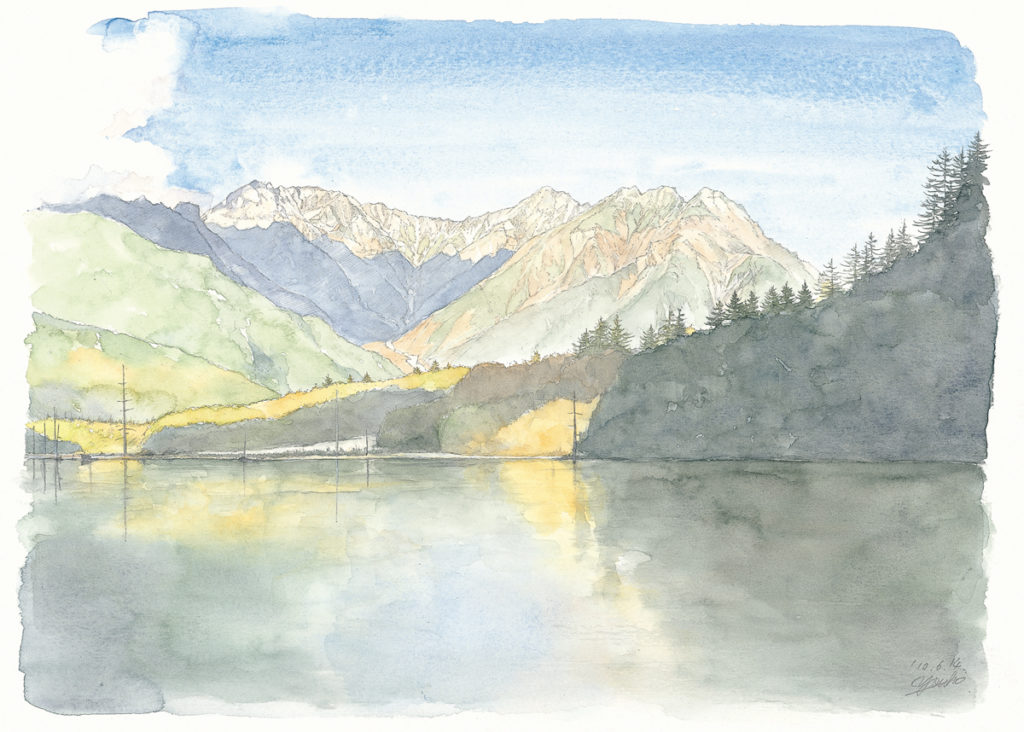
illustration | Yohei Naruse
Most of the Mt. Hodaka paintings by Hiroshi were of the peak as seen from Kamikochi, as in “Twelve Views of the Japan Alps”. In the artist’s own words:
“The magnificent view of the cliffs visible from Kamikochi is worthy of special mention. These cliffs, which tower like a folding screen from the base to the top, are visible immediately. Here and there, the lingering white snow is still piled up. This is a view that unambiguously conveys the charm of alpine beauty, even to those who have never encountered it before.”
In those days, when there was no road to Kamikochi, the shortest route was to walk over the Tokumoto Pass.
“It is safe to say these cliffs are not only an attraction of Kamikochi, but also form the core of the scenic beauty of the summit of Tokumoto Pass leading up to Kamikochi. After a long and relatively monotonous ascent, when you finally reach the top of the pass, the view of the cliffs against the backdrop of Mt.Hodaka is unprecedentedly spectacular, in fact nothing short of thrilling.”
Despite his huge love of Mt. Hodaka, none of his works depict its rugged rocky ridges; the sole mention of a cliff with many falling rocks is the one of Mt.Kita Hodaka. This seems to have something to do with Hiroshi’s conception of “alpine beauty” that he was somewhat fixated on when painting. While Hiroshi remarked that “the most magnificent alpine beauty is experienced” when standing at the summit of a mountain range with “a kind of purifying ambience unique to alpine mountains,” he added the caveat that, “mountains are not the only things that can be beautiful. One can encounter alpine beauty everywhere, in the valleys, rivers, forests, and plateaus around the mountains. There are indeed some mountains that are more beautiful to look at from afar than to clamber up. Hiroshi wrote that “Kamikochi is simply magnificent in terms of the beauty of the view witnessed from the foot of the mountain”. However, what captivated and moved him the most was surely the sight of Mt. Hodaka from Kamikochi soaring like a folding screen, flanked by verdant forests and the picturesque Azusa River flowing by.
I woke up before dawn to a deep, absorbing indigo sky. The silvery white moon and countless stars bid a lingering farewell above the stark rocky peaks. The rocky surface, lightly blanketed in snow as if sprinkled with powdered sugar, morphs from pale orange to red. As the sun rises, the mountains are bathed in white light, causing the leaves of the Sorbus commixta (Japanese rowan trees) to glow a brilliant reddish brown.
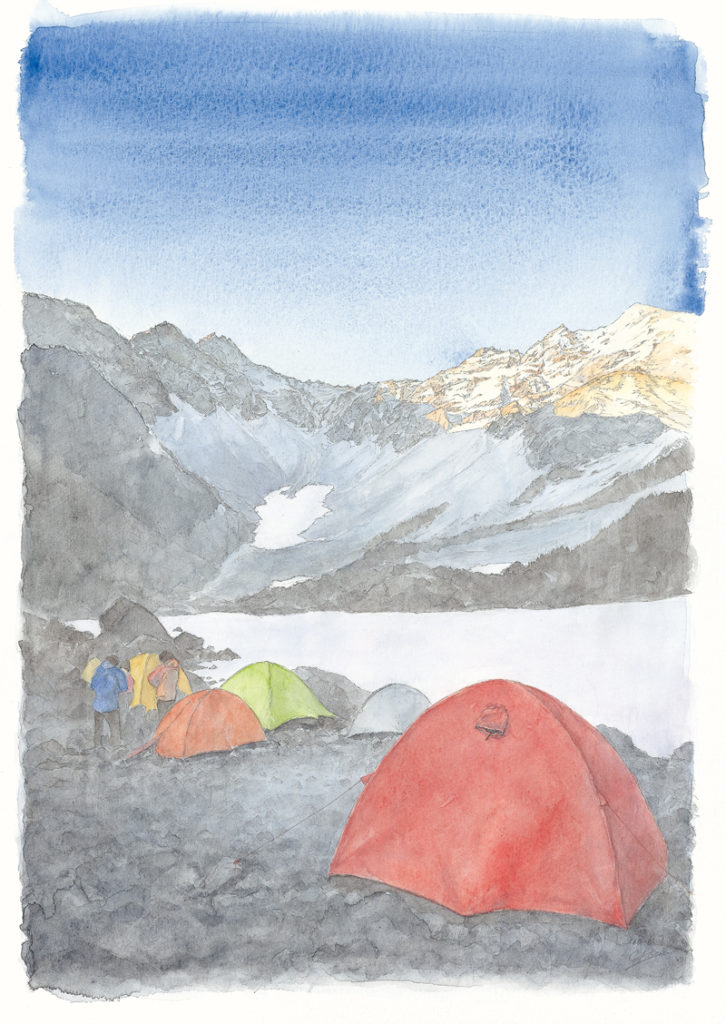
illustration | Yohei Naruse
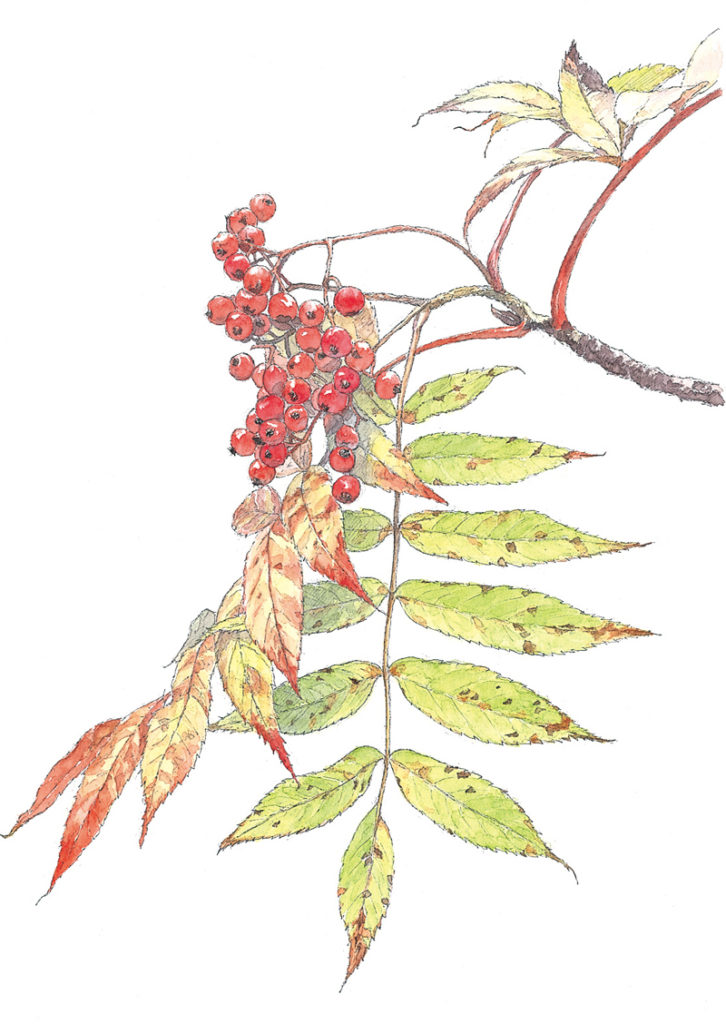
illustration | Yohei Naruse
Hiroshi Yoshida traversed the Northern Alps many times, and one of his writings includes a description “from Nakabusa to Kamikochi via Yari and Hodaka.” Presumably, he ascended Mount Tsubakuro from Nakabusa Onsen, traversed Yarigatake, Kita-Hodaka, Oku-Hodaka, and Mae-Hodaka from the Higashikama Ridge before descending to Kamikochi. The rocky ridge from Yarigatake to Kita-Hodaka is still considered difficult today. Considering the state of mountain trails and equipment at the time, it must have been a tall order.
As I climbed to the top of Mt. Karasawa, the mist that had welled up from the west dazzlingly reflected the light as it cascaded over the mountain. The rocky surface of Mt.Oku Hodaka is tinted yellow by the western sun, while the north face of Mt.Mae-Hodaka, where the snow had not yet melted, casts a cold shadow reminiscent of blue ice. Just as the sun is about to set in the sea of clouds occupying the landscape to the west, it defiantly shines with an intense light, turning the mountains a deep crimson that seemed to set them ablaze, before quietly losing its luster. Beyond the rocky peaks of the Gendarme sinking into the evening sea, a solitary orange-tinted cloud flutters indefinitely.
Mt. Hodaka is a mountain for which Hiroshi’s affection never waned, and he even named his second son after it. Hodaka Yoshida remarked thus: “My father’s first gift to me was ‘Hodaka”, a name that has a lovely ring to it. It is a symbol of my father’s love for the mountains and his constant painting of them, and as such is a precious talisman for me.”
<PAPERSKY no.33(2010)>
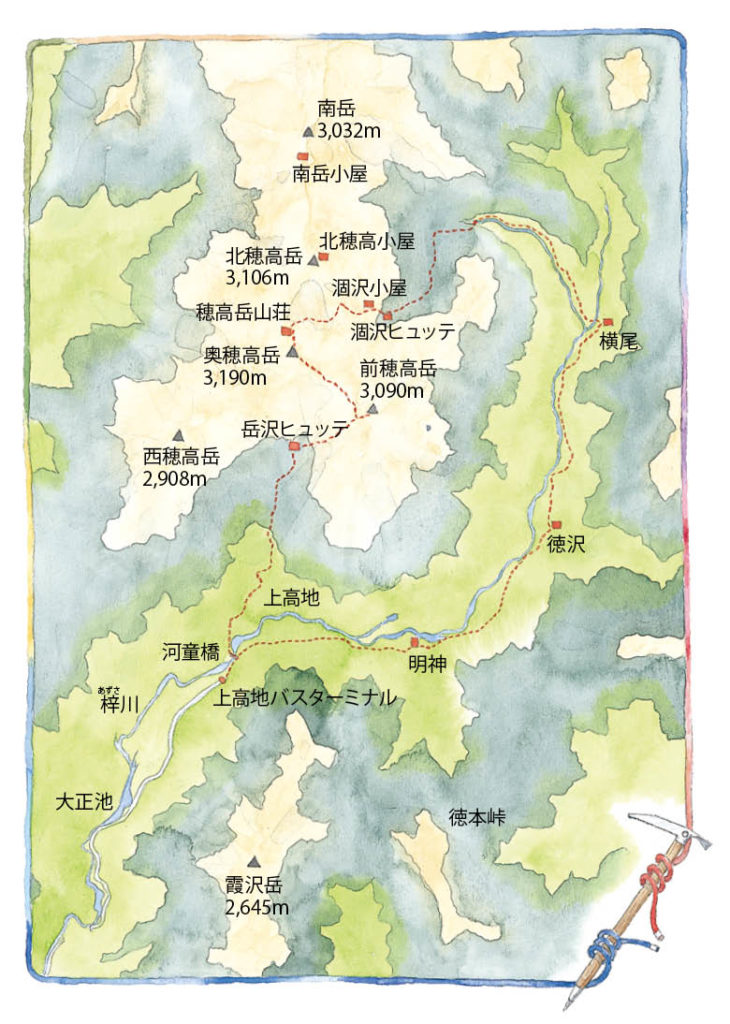
route information
The Hodaka mountain range, which includes Oku Hodaka, Japan’s third highest peak, as well as Kita-hodaka, Mae-hodaka, and Nishi-Hodaka, is one of Japan’s major mountain ranges, boasting alpine scenery comparable to that of the European Alps with its glacier-carved dry river bed curls and sheer rocky peaks. From Kamikochi, a flat trail continues along the Azusa River, becoming a full-on mountain trail from Yokoo. A popular route is from Mt.Karasawa to Mt.Okuhodaka, traversing along the Tsuri-one ridge to Mt.Mae-Hodaka, and then descending to Kamikochi, staying overnight at the Karasawa and Hodaka lodges. If tackling Oku-Hodaka only, one can descend again to Karasawa. There are scrambling spots and ladders to negotiate on the Seitengrat and the ridge line from Karasawa up to Mt. Okuhodaka. The Dakezawa Hutte collapsed due to an avalanche in 2006 and went out of business but was rebuilt and reopened as the “Dakezawa Hut” in 2010.
Yohei Naruse
Born in Gifu Prefecture in 1982. Graduated Tsuru University, Graduate School. Following a stint in advertising, he currently works as a freelance writer and illustrator.











